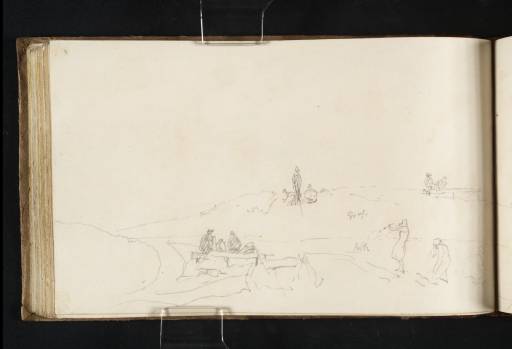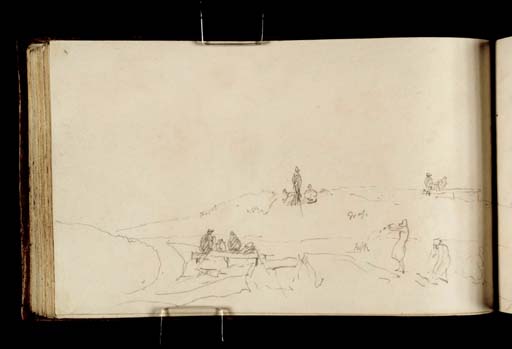Joseph Mallord William Turner Figures on Calton Hill 1818
Image 1 of 2
Joseph Mallord William Turner,
Figures on Calton Hill
1818
Joseph Mallord William Turner 1775–1851
Folio 42 Verso:
Figures on Calton Hill 1818
D13653
Turner Bequest CLXVII 40a
Turner Bequest CLXVII 40a
Pencil on white wove paper, 112 x 186 mm
Inscribed in pencil by Turner [?]‘Grafs | Parth’ centre right
Inscribed in pencil by Turner [?]‘Grafs | Parth’ centre right
Accepted by the nation as part of the Turner Bequest 1856
References
1909
A.J. Finberg, A Complete Inventory of the Drawings of the Turner Bequest, London 1909, vol.I, p.486, CLXVII 40a, as ‘Figures on Calton Hill.’.
1910
Alexander J. Finberg, Turner’s Sketches and Drawings, London 1910, pp.107–8.
1997
Charles Nugent and Melva Croal, Turner Watercolors from Manchester, exhibition catalogue, Memphis Brooks Museum of Art, Memphis 1997, p.61 under cat.33.
1999
Katrina Thomson, Turner and Sir Walter Scott: The Provincial Antiquities and Picturesque Scenery of Scotland, exhibition catalogue, National Gallery of Scotland, Edinburgh 1999, p.85 note 21.
This double-page sketch (continuing on folio 43; D13654; CLXVII 41) shows Edinburgh at leisure, with people relaxing, drying clothes and enjoying the view from Calton Hill. The hill – which can boast the grandest views of the city and surrounding country including views along the Firth of Forth to the Bass Rock – was developed as a leisure spot during the eighteenth and nineteenth centuries, with pleasure gardens and paths (one of which is shown in Turner’s drawing where it is inscribed, ‘path’).
The drawing is closely related to a previous drawing in this sketchbook (folio 41 verso; D13651; CLXVII 39a), which formed the basis of Turner’s watercolour design for Edinburgh, from Calton Hill, circa 1819 (National Gallery of Scotland) for Walter Scott’s Provincial Antiquities .1 The two figures, one standing the other sitting at the edge of the hill enjoying the view, may be the same as those on folio 41 verso – though they have exchanged positions. The watercolour includes about a dozen figures in the foreground, with figures on a bench, as on the present page, and people drying clothes, including notably a woman shaking out a cloth or shirt that directly derives from this sketch, though the direction of the wind has changed.
Finberg describes this process of adapting the figure from this sketch for the finished design as ‘Turner’s habit of using his notes rather as hints to his imagination than on providing ready-made material waiting for immediate incorporation.’ As he goes on to say: ‘The figures in the drawing are indeed the same sort of people as in the sketch, but each is designed specially for its place, and with reference to the movement of the whole picture’.2 The inclusion of local figures, involved in typical activities is a common feature of Turner’s topographical views, and he was always keen to endow his landscapes with a figurative presence and human interest. The sketch on the present page records the process by which this was achieved.
Thomas Ardill
March 2008
How to cite
Thomas Ardill, ‘Figures on Calton Hill 1818 by Joseph Mallord William Turner’, catalogue entry, March 2008, in David Blayney Brown (ed.), J.M.W. Turner: Sketchbooks, Drawings and Watercolours, Tate Research Publication, December 2012, https://www


